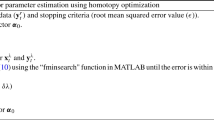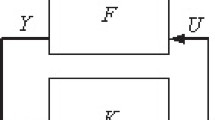Abstract
In this paper, we present a novel solution to the minimum attention control problem for linear systems. In minimum attention control, the objective is to minimise the ‘attention’ that a control task requires, given certain performance requirements. Here, we interpret ‘attention’ as the inverse of the interexecution time, i.e., the inverse of the time between two consecutive executions. Instrumental for our approach is a particular extension of the notion of a control Lyapunov function and the fact that we allow for only a finite number of possible interexecution times. By choosing this extended control Lyapunov function to be an ∞-norm-based function, the minimum attention control problem can be formulated as a linear program, which can be solved efficiently online. Furthermore, we provide a technique to construct a suitable ∞-norm-based (extended) control Lyapunov function. Finally, we illustrate the theory using a numerical example, which shows that minimum attention control outperforms an alternative ‘attention-aware’ control law available in the literature.



Similar content being viewed by others
Notes
Note that all the control laws discussed in this section have larger computational complexity than a standard sampled-data controller. However, these control laws require fewer executions and thus fewer transmissions of measurements and actuator signals, which is particularly relevant in control application where computation is ‘cheap’ and communication is ‘expensive’. As such, the focus of this paper is to ‘trade communication for computation’ (Yook et al. 2002).
In this example, we only compare our newly developed control strategy with Mazo Jr et al. (2010) and not with Anta and Tabuada (2010), Velasco et al. (2003) and Wang and Lemmon (2009). The reason is that this method is the most suitable one for comparison as Velasco et al. (2003) only proposed the concept of self-triggered control and did not provide a systematic way to design the triggering condition, Anta and Tabuada (2010) reduces to periodic control when applied to linear systems, and Wang and Lemmon (2009) focusses on disturbance attenuation and not on achieving a certain convergence rate α and gain c.
References
Anta A, Tabuada P (2010) On the minimum attention and anytime attention problems for nonlinear systems. In: Proc. conf. decision & control, pp 3234–3239
Anta A, Tabuada P (2010) To sample or not to sample: self-triggered control for nonlinear systems. IEEE Trans Automat Contr 55:2030–2042
Åström KJ, Wittenmark B (1997) Computer controlled systems. Prentice Hall
Brockett RW (1997) Minimum attention control. In: Proc. conf. decision & control, pp 2628–2632
Chen T, Francis BA (1995) Optimal sampled-data control systems. Springer
Donkers MCF, Heemels WPMH (2012) Output-based event-triggered control with guaranteed \(\mathcal{L}_\infty\)-gain and improved and decentralised event-triggering. IEEE Trans Automat Contr 1362–1376
Heemels WPMH, Sandee JH, van den Bosch PPJ (2008) Analysis of event-driven controllers for linear systems. Int J Control 81:571–590
Henningsson T, Johannesson E, Cervin A (2008) Sporadic event-based control of first-order linear stochastic systems. Automatica 44:2890–2895
Kellett CM, Teel AR (2004) Discrete-time asymptotic controllability implies smooth control-lyapunov function. Syst Control Lett 51:349–359
Khalil HK (1996) Nonlinear systems. Prentice Hall
Kiendl H, Adamy J, Stelzner P (1992) Vector norms as Lyapunov function for linear systems. IEEE Trans Automat Contr 37(6):839–842
Kvasnica M, Grieder P, Baotić M (2004) Multi-parametric toolbox (MPT). http://control.ee.ethz.ch/~mpt/
Lunze J, Lehmann D (2010) A state-feedback approach to event-based control. Automatica 46:211–215
Mazo M Jr, Anta A, Tabuada P (2010) An ISS self-triggered implementation of linear controllers. Automatica 46:1310–1314
Polański A (1995) On infinity norms as Lyapunov functions for linear systems. IEEE Trans Automat Contr 40(7):1270–1274
Sontag E (1983) A Lyapunov-like characterization of asymptotic controllability. SIAM J Control Optim 21(3):462–471
Tabuada P (2007) Event-triggered real-time scheduling of stabilizing control tasks. IEEE Trans Automat Contr 52:1680–1685
Velasco M, Fuertes JM, Martí P (2003) The self triggered task model for real-time control systems. In: Proc. IEEE real-time systems symposium, pp 67–70
Walsh G, Ye H (2001) Scheduling of networked control systems. IEEE Control Syst Mag 21(1):57–65
Wang X, Lemmon M (2009) Self-triggered feedback control systems with finite-gain \(\mathcal{L}_2\) stability. IEEE Trans Automat Contr 45:452–467
Yook JK, Tilbury DM, Soparkar NR (2002) Trading computation for bandwidth: reducing communication in distributed control systems using state estimators. IEEE Trans Control Syst Technol 10(4):503–518
Yépez J, Velasco M, Martí P, Martín EX, Fuertes JM (2011) One-step finite horizon boundary with varying control gain for event-driven networked control systems. In: 37th annual conference of the IEEE industrial electronics society
Author information
Authors and Affiliations
Corresponding author
Additional information
This work is partially supported by the Dutch Science Foundation (STW) and the Dutch Organisation for Scientific Research (NWO) under the VICI grant ‘Wireless controls systems: A new frontier in automation (no.11382)’, by the 7th Framework Programme of the European Commission under the grants ‘Decentralised and Wireless Control of Large-Scale Systems (WIDE-224168)’ and ‘Highly-Complex and Networked Control Systems (HYCON2-257462)’, and by the National Science Foundation (NSF) under the grant ‘An Anytime Approach to Embedded Real-Time Control (0834771)’.
Appendix: Proofs of Theorems and Lemmas
Appendix: Proofs of Theorems and Lemmas
Proof
(Lemma 2) Since Eq. 11 holds and since the solutions to Eq. 1 with Eq. 2 satisfy
we have that
for all l ∈ {0, ..., L − 1} and for all t k , k ∈ ℕ, with \(\hbar_0=0\). Now using Eq. 10, we have that Eq. 32 implies
for all l ∈ {0, ..., L − 1} and for all t k , k ∈ ℕ, with \(\hbar_0=0\). Moreover, because it holds that \(\| \hat{u}_k \| \leqslant \beta \| x(t_k) \|\), the solutions to Eq. 1 with Eq. 2 also satisfy
for all \(t\in[t_k+\hbar_l,t_k+\hbar_{l+1})\), k ∈ ℕ, l ∈ {0, ..., L − 1}, with \(\Delta_\hbar\) as defined in the hypothesis of the lemma. Substituting Eq. 33 into this expression (twice) yields
for all \(t\in[t_k+\hbar_l,t_k+\hbar_{l+1})\), k ∈ ℕ, l ∈ {0, ..., L − 1}. Now realising that for all \(t\in[t_k+\hbar_l,t_k+\hbar_{l+1})\), k ∈ ℕ, l ∈ {0, ..., L − 1}, it holds that \(e^{-\alpha (t_k+\hbar_l)} < e^{-\alpha t + \alpha\Delta_\hbar}\) and that \(e^{-\alpha t_k} < e^{-\alpha t + \alpha \hbar_L }\) we have Eq. 4 with c as given in the hypothesis of Lemma 2.□
Proof
(Theorem 1) Using the arguments given in Section 3.3, we have that the hypotheses of the theorem guarantee that F MAC(x) ≠ ∅ for all \(x\in\mathbb{R}^{n_x}\). By following a similar reasoning as done in the proof of Lemma 2, we can show that the MAC law guarantees that Eq. 35 holds for all \(t\in[t_k+\hbar_l,t_k+\hbar_{l+1})\), k ∈ ℕ, \(l\in\{0,\ldots,\bar{L}^\star(x(t_k))-1\}\), with \(\hbar_0=0\), and all \(x\in\mathbb{R}^{n_x}\). Again realising that for all \(t\in[t_k+\hbar_l,t_k+\hbar_{l+1})\), k ∈ ℕ, \(l\in\{0,\ldots,\bar{L}^\star(x(t_k))-1\}\), it holds that \(e^{-\alpha (t_k+\hbar_l)} < e^{-\alpha t + \alpha\Delta_\hbar}\) and that \(e^{-\alpha t_k} < e^{-\alpha t + \alpha \hbar_{\bar{L}^\star(x(t_k))}} \leqslant e^{-\alpha t + \alpha \hbar_L}\) yields Eq. 4 with gain \(c=\bar{c}(\alpha,\beta,\Delta_\hbar,\hbar_L)\) as in Eq. 13.□
Proof
(Lemma 3) The proof follows the same line of reasoning as in Kiendl et al. (1992) and Polański (1995). GES of Eq. 1 with Eq. 19 with convergence rate \(\hat\alpha\) and gain \(\hat{c} = \overline{a}/\underline{a}\) is implied by the existence of a positive definite function, satisfying Eq. 10 and
for all t ∈ ℝ + , which follows from the Comparison Lemma, see, e.g., Khalil (1996). Now using the fact that the solutions to Eq. 1 with Eq. 19 satisfy \(\tfrac{\mathrm{d}}{\mathrm{d}t}x = (A+BK) x\), and using Eq. 17, we obtain that Eq. 36 is implied by
for all t ∈ ℝ + . Using Eq. 20a, we have that, for all t ∈ ℝ + , Eq. 37 implied by
which is, due to positivity of ||Px|| ∞ for all x ≠ 0, equivalent to \(\lim_{s\downarrow0} \tfrac{1}{s} ( \| (I + s Q ) \|_\infty - 1 ) \leqslant -\hat\alpha\), which is implied by Eq. 20b. This completes the proof.□
Proof
(Lemma 4) The proof is based on showing that the Lyapunov function obtained using Lemma 3 also guarantees Eqs. 1 and 2, with Eq. 21 and t k + 1 = t k + h, k ∈ ℕ, to be GES with convergence rate α and gain \(c:=\bar{c}(\alpha,\beta,h)\), where \(\bar{c}(\alpha,\beta,h)\) as in Eq. 9, for all h < h max(α) as in Eq. 22. To do so, observe that the solutions of Eqs. 1 and 2, with Eq. 21 and t k + 1 = t k + h, k ∈ ℕ, satisfy
for all t ∈ [t k ,t k + h), k ∈ ℕ. Now by following the ideas used in the proof of Lemma 2, and the candidate Lyapunov function of the form of Eq. 17, we have that GES with convergence rate α and gain c of Eqs. 1 and 2, with Eq. 22 and t k + 1 = t k + h, k ∈ ℕ, is implied by requiring that
for all t k , k ∈ ℕ, and some well-chosen h > 0. Substituting Eq. 39 and defining \(\hat{x} := P x\), yielding \(x = (P^\top P)^{-1}P^\top \hat{x}\), yields that Eq. 40 is implied by
for all \(\hat{x}(t_k)\in\mathbb{R}^m\), which holds for all h > 0, satisfying h < h max(α), as given in the hypothesis of the lemma, meaning that Eq. 40 holds for all \(\hat{x}(t_k)\in\mathbb{R}^m\) and for all h > 0, satisfying h < h max(α). This completes the proof.□
Proof
(Theorem 2) As a result of Lemma 4, we have that the control input given by Eq. 21 renders the plant with ZOH, Eqs. 1, 2, GES with convergence rate α and gain \(c:=\bar{c}(\alpha,\|K\|_\infty,h)\) as in Eq. 9, for any interexecution time h < h max(α) as in Eq. 22. To obtain a well-defined control law, we need that F MAC(x) ≠ ∅, for all \(x\in\mathbb{R}^{n_x}\), which is guaranteed if and only if Eq. 14 satisfies F 1(x) ≠ ∅ for all \(x\in\mathbb{R}^{n_x}\), as argued in Section 3.3. This can be achieved by choosing \(\beta\geqslant\|K\|_\infty\) and choosing the set \(\mathcal{H}:=\{\hbar_1,\ldots,\hbar_L\}\), L ∈ ℕ, such that \(\hbar_1<h_{\max}(\alpha)\), as this yields that \(F_1(x) \supseteq \{ K x \} \neq \emptyset\), if V is chosen as in Eq. 17. GES with the convergence rate α and the gain \(c\geqslant\bar{c}(\alpha,\beta,\Delta_\hbar,\hbar_L)\) of Eqs. 1, 2 and 3, with Eqs. 8, 14, 15, 16 and 17, follows directly from Theorem 1. This completes the proof.□
Rights and permissions
About this article
Cite this article
Donkers, M.C.F., Tabuada, P. & Heemels, W.P.M.H. Minimum attention control for linear systems. Discrete Event Dyn Syst 24, 199–218 (2014). https://doi.org/10.1007/s10626-012-0155-x
Received:
Accepted:
Published:
Issue Date:
DOI: https://doi.org/10.1007/s10626-012-0155-x




